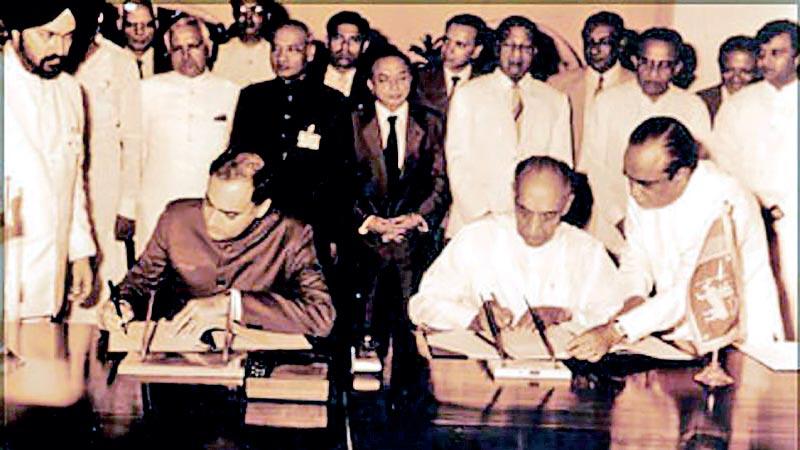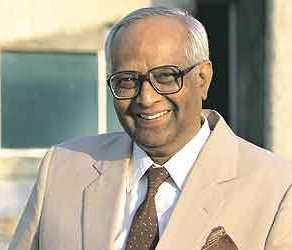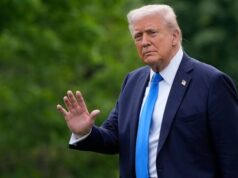How I was Arrested by the CID and Detained on the 4th Floor?
By
D B S Jeyaraj

Indian Premier Rajiv Gandhi and Sri Lankan President J.R. Jayewardene signing the INd0_Lanka Peace Accord in 1987.
Thirty-six years ago in October 1987, I was arrested by the Sri Lankan Police and detained at the Criminal Investigation Department (CID) Office on the fourth floor of the Police Secretariat in Fort, Colombo.
I was then working as a journalist for The Island in Colombo. I was also the Sri Lanka Correspondent of the Indian English daily The Hindu and newsmagazine Frontline.
The United National Party (UNP) Government headed by President Junius Richard (JR) Jayewardene was in power then.
President Jayewardene and the then Indian Prime Minister Rajiv Gandhi had signed an agreement on July 29, 1987. This historic agreement referred to as the Indo-Lanka Accord temporarily ended the conflict between the Sri Lankan armed forces and the Tamil militant organizations including the Liberation Tigers of Tamil Eelam (LTTE). An Indian Peace Keeping Force (IPKF) was stationed in the Northern and Eastern provinces of the Island
Fighting broke out between the IPKF and LTTE on 10 October 1987. I was in Jaffna at that time and witnessed the eruption of war. I returned to Colombo on 21 October and wrote articles and news stories in detail about what was happening in Jaffna for the Sunday Island of 25 October 1987.
An exclusive interview with the then LTTE deputy-leader Gopalaswamy Mahendrarajah alias Mahathaya was also published.
My writings about prevailing realities in Jaffna contradicted the ‘official version’ then being trotted out by the powers that be about the war against the LTTE.
I was arrested by the Police on Monday 26 October and detained at the then CID Headquarters on the 4th floor of the Police Secretariat in Colombo 1.
Recently a post-graduate student interviewed me about the circumstances of my arrest and detention for her PhD thesis on media suppression in Sri Lanka.
I had written about my arrest-related matters in detail, 26 years ago for The Island newspaper and had to wander down memory lane again. It is against this backdrop that I re-visit my arrest and detention in October 1987 with the aid of earlier writings in this article. It is a first-person account of my experiences.

Indian Ambassador J.N. Dixit
Jaffna Special
The Sunday Island edition of October 25th 1987 was virtually a Jaffna special focussing on the Indian Army campaign against the Tigers in the north. The lead story was an on-the-spot account written in detail by me. There were also two articles. One was the extensive interview conducted with Mahaththaya, the LTTE deputy leader.
The second was the first instalment of an in-depth series on the Jaffna war titled Jaffna in Flames.
Both were my pieces. In addition, there were many photographs in colour and black and white of the action in Jaffna brought by me. There was also a letter outlining in detail the problems faced by the people of Jaffna in the wake of the Indian Army campaign.
This letter was signed by 14 top Govt officials in Jaffna. I have obtained a copy from the then Jaffna GA Panchalingam. All these were exclusives for The Island. The paper sold like hotcakes and by Sunday afternoon was sold out in Colombo and the suburbs.
Agitated and Angry
On Sunday evening an Indian Journalist friend Mazumdar, the All India Radio correspondent in Colombo telephoned me. He warned me that the Indian High Commission people were agitated and angry about me.
“They are fuming and may try to fix you,” he said.
On the following day, my Sri Lankan journalist friend Rita Sebastian writing for the Indian Express paper also called me. Mentioning some Indian Diplomats by name this colleague said “They are ranting and raving at you.”
Rita also said that the Indian High Commission had suspended its usual evening press conference on the war dubbed by Journalists as the Four PM Folly. These press conferences had been painting glowing pictures about the situation in Jaffna. The Island reports had exposed the real situation and the regular Indian press conference had lost credibility.
The Indian diplomats also feared a barrage of questions by the International media based on my news reports. Already the International media was quoting The Island on the issue. Also, some Western journalists like John Rettie of the BBC had quoted me in their despatches.
Veteran journalist Mervyn de Silva who had good contacts at the Indian High Commission invited me for lunch on that Monday the 26th.
After congratulating me on the journalistic scoops, he too advised me to be careful. Mervyn said something like this:
“Ever since this war began we have been regaled with sunshine stories about Jaffna from the Indian side. They made us believe that hundreds of Tigers were being killed in Jaffna and that civilians were not being harmed at all. Now the true picture has emerged. So you had better watch your back. If I were you I’ll try and make peace with Mani, Hardeep and Lakshmi.” Mani, Hardeep and Lakshmi refer to the then Indian High Commissioner JN Dixit, Political Secretary Hardeep Singh Puri and Information Secy Lakshmi Puri respectively.
Mr Perera
When I returned to the Island editorial one of the messages waiting for me was from Mr Perera.
He wanted to meet me on an urgent matter. I tried calling the Indian diplomats but I could not get through to them. A little later Mazumdar of AIR called me again and said “Mani (Dixit) contacted the old boy (JRJ) on your matter last night (Sunday). There may be fireworks”.
Any possible qualms that I may have had began evaporating as colleagues at The Island and Divaina continued to be hearty in their approbation and lavish in their praise for my journalistic scoops. I enjoyed that.
There were also numerous congratulatory telephone calls from both friends and unknown readers. Many foreign correspondents were phoning and asking for appointments. Some overseas media organizations were interviewing me by telephone. My feel-good factor was at its highest and I was really on top of my small world.
I was at my desk writing out an interview with EROS Leader Balakumaran that I had obtained in Jaffna when the security people at the guardroom rang and said that one Mr Perera was waiting at the gate. I asked them to send him to reception but was told that he did not want to come in. So I went to the gate.
The youngish-looking ‘Perera’ spoke softly in Sinhala and whispered”
“We are from the Janatha Vimukthi Peramuna (JVP) Our central committee member is in the car. Can you please interview him?”
The JVP was then a proscribed organization fighting an anti-Indian war of its own by killing Sinhala persons in the south.
Suspecting a hoax I said “Why are you asking me a Tamil journalist who is not very fluent in Sinhala?
He replied “At this point, we cannot trust a Sinhala journalist. We need a Tamil Journalist. We saw your interview with Mahaththaya and thought you would be appropriate. Our central committee member knows English well and you can talk to him”
I then said that I must consult my editor Gamini Weerakoon and get his go-ahead. “Perera” replied, “Meet our central committee man first. If you are satisfied then tell the editor. Also, it may be difficult to arrange for another time. If you want an interview take it now. Later even if your editor refuses to carry the Interview we will understand “. It had also started drizzling.
There is a Christian Hymn which begins “Once to every man and nation comes the moment to decide”. This was my moment of decision. I said “Yes but can you arrange an Interview with Rohana Wijeweera (JVP leader) or Upatissa Gamanayake (JVP Secy)?
The journalistic impulse that governed most of my actions felt that an interview with one of them would be another scoop. Again the reply was to talk to our central committee member and he will arrange it.
The ongoing drizzle was now increasing in volume. Perera said
“There is going to be a shower. Why not get into our car and talk?
I nodded and we ran across to the two-door orange Volkswagon parked opposite the eating house known as “Kaputa Kade”.
I was asked to get into the back seat. After sitting I realised that I could not get out of the car even if I wanted to. I was slightly uneasy but not very much.
Interview with JVP
I was introduced to the Central committee member to whom I put forward my request for an interview with the JVP leaders. He said I may be able to get Comrade Rohana for you. But you have to come with me now to a place in Fort from where I will phone someone. If you are lucky you may be able to get the Interview today itself”.
It seemed to be a now-or-never situation. It was risky. My adventurous spirit impelled me onwards, YES I said.
So, I left with them instead of going back to the Editorial and informing the editor or somebody else. In retrospect a big mistake.
In the car, I began chatting to the so-called JVPers. I began to feel that something was not quite right. They seemed more like Police or security personnel. Suddenly a frightening thought struck me. The death squad phenomenon was beginning to rear its ugly head then. Was I a target because of my reporting?
Nobody knew where I was or with whom I was going. I was worried now but nothing was to be done. As the car circled Fort I said in Sinhala “You all are not JVP You all are Policemen.”
The three men laughed but said nothing. The car turned into the Police Headquarters. I was taken into the CID Director’s office.
Strange as it may seem, I heaved a sigh of relief. I now felt that I was not being subject to any unofficial activity. Whatever happened, unpleasant as it may be was going to be official.
CID Director
The CID Director then was DIG Bennet Perera. He read out Sections from the Prevention of Terrorism Act (PTA) and the Emergency Regulations.
He said that I had met with Mahaththaya a terrorist leader and had not informed the Police. This was a violation of the PTA he said.
I replied that I had in 1984 and 1985 met several Tamil armed group leaders in Madras and Interviewed them.
Before undertaking that venture I had consulted former National Security Minister Lalith Athulathmudali who assured me that the relevant PTA provision would not apply to journalists.
Likewise, no action of that type was taken when some of the interviews appeared on the Island.
I also said that I was the first Sri Lankan Journalist to interview the Tamil group leaders. Subsequently, other reporters too had done so. No action had been taken. So, why was I being singled out now I queried. In any event why not the CID Chief clarify the issue from Lalith Athulathmudali himself? I was told that Lalith was convalescing after the Parliament Bomb attack and could not be reached.
I then pointed out that politicians like Vijaya Kumaratunga and UNP Yatiyantota MP Vincent Perera had gone to Jaffna and met the LTTE Jaffna Commander Krishnakumar alias Kittu. They were not penalised in any way, I pointed out.
Thereafter I said that as far as I was concerned I had nothing to hide and that I had written about my meeting Mahaththaya publicly.
I was also continuing my writing on the Jaffna trip and more details would be revealed in due course. There was nothing illegal or underhand in what I was writing I emphasised.
Defence Secretary
I was then shown a letter purportedly written by then Defence Secretary Gen. Sepala Attygalle. The letter referred to my interview with Mahathaya and said that some details about the murder of the Rupavahini crew by the LTTE could be obtained from me.
Four Sinhala employees of Rupavahini TV had been murdered by the LTTE in Jaffna. Attygalle’s letter instructed the Police to question me further on this matter.
What happened thereafter will be related in the second part of this article.
Source : Daily Mirror




